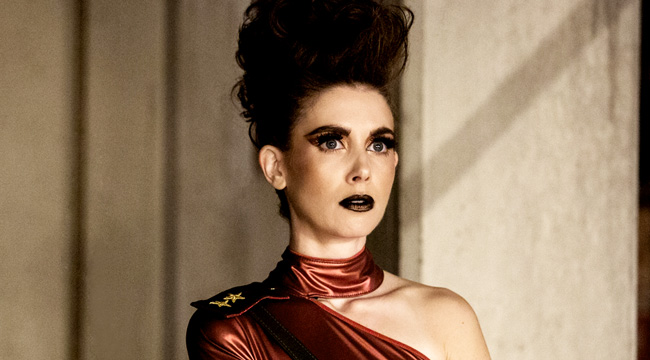
The debut season of GLOW felt special, a bright and confident series that easily stood out among dozens of new Netflix offerings. It boasted a cast of mostly women, a lively premise (based on the real-life Gorgeous Ladies Of Wrestling), and, it seems, a sizable budget dedicated to hairspray. The second season is even better (and brighter), allowing sidelined women to share the spotlight, finding depth in one-note characters, and moving past the generic origin story to create something bigger. Also: montages. Glorious, neon montages.
Last season was immensely fun but sometimes felt like an extra long pilot episode, largely because the women were working toward making their own pilot. It spent a while introducing characters and setting up the wrestling world, culminating with a triumphant finale that landed them a TV time slot. The second season begins shortly after and follows the wrestlers as they film their first season. Free from introductory and expository constraints, GLOW opens itself up to look closer, to really dig into these characters, and — in a great blend of comedy and drama — depict the frustrations of being a woman in a sexist, professional environment. As the show-within-a-show begins airing (and garnering a small, loyal fanbase), increasing pressure and demands weigh on the women, causing outward arguments and inner conflicts.
Ruth (Alison Brie) and Debbie (Betty Gilpin) spent last year stuck in an antagonistic cycle related to Ruth sleeping with Debbie’s husband (Rich Sommer). It’s an easy way to set up the friends-turned-rivals storyline, and whether or not they can rekindle that friendship is a nice platonic will-they/won’t-they, but it still felt like a generic “two women fight over a man” trope — out of place with the rest of the series’ ideals. (A telling and admirable element of GLOW: there are barely any romantic relationships; these women have their careers first.) But now, Ruth is coming into her own as Sam’s (Marc Maron) unofficial Number Two — even taking it upon herself to direct an adorable, cheesy title sequence shot in a mall — while Debbie snags a producer credit so she can have input in creative decisions. In their personal lives, Ruth finds herself surrounded with support and friendship (possibly for the first time) while Debbie’s impending divorce is causing her to spiral, making rash decisions and lashing out. By giving both women professional goals, rich inner lives, and insight into their basic personality traits, their conflict plays out better and feels more natural. We now understand the extent of Debbie’s pain and why Ruth sabotaged their friendship, so it makes the fights in season two absolute knockouts (especially due to Brie and Gilpin’s pitch-perfect performances). When they have a put-it-all-on-the-table screaming match in a less than idea location, it’s an immediate — but heartbreaking — highlight of the entire season.
One of the best things about watching GLOW — besides those montages, of course — is seeing how creators Liz Flahive and Carly Mensch address some common criticisms. For one, it was absurd that the entirety of the wrestling league consisted of straight women; season two quickly introduces a queer character and hints at the sexuality of some others. The two token men (how I love that there are token men!), perpetually grumpy Sam and rich kid-at-heart Bash (Chris Lowell, having fun in his ’80s-tastic outfits) also become multi-dimensional, though never too much to betray their characters. Sam may have started ironing his shirts (“What is this? I feel like someone else!”) but he’s still doing coke in his car; he may be letting his newly-discovered daughter Justine (Britt Baron) crash with him, but he has no idea how to be a father. Bash is still silly fun (he confuses the meaning of “prep day,” showing up in a preppy outfit) but GLOW throws him for a loop with a darker storyline that forces him to look inward.
GLOW has definitely been clumsy when it comes to race — maybe you could argue it’s mirroring how wrestling in general is consistently clumsy with race — especially with Arthie (Sunita Mani), an Indian-American forced to play “Beirut the Mad Bomber,” and Tamme (professional wrestler Kia Stevens) whose character is named “The Welfare Queen.” These characters will feel familiar to wrestling fans (particularly if you watched in the ’80s and ’90s) but, even when the women expressed hesitant concern, season one didn’t fully allow them to parse the personal pain that comes along with promoting insensitive stereotypes. Season two finds Arthie outspoken about how terrible the pilot episode made her feel (she laments her costume smells like beer and racism) as she tries to find ways to destroy her own character and become someone new. Tamme gets the better plot in one of the season’s best episodes, in which she has to look at herself through the eyes of her Stanford-attending son, who views “Welfare Queen” as akin to minstrelsy.
GLOW also, unsurprisingly, reflects the #MeToo movement with a Harvey Weinstein-inspired plot that is, at once, straight-forward and more complex than many recent series who went similar routes. It helps that GLOW has always been smartly aware of the dynamics and imbalance between men and women, and especially in Hollywood. “If you want to be respected, you gotta make yourself useful,” Tamme tells Debbie in an early episode, “Unless you’re a white man. Then you just have to show up and wait around and eventually get promoted.”
Even when it skews dramatic, GLOW pulls off a balancing act, interjecting serious moments with fun costumes, energetic in-ring performances, absurd gimmicks, and left-field jokes. It doesn’t maintain the fun and non-stop entertainment of the first season but instead doubles it — the eighth episode, in particular, is one that I’ll surely watch five more times this summer alone. The women might still be underdogs, but GLOW has already won.






